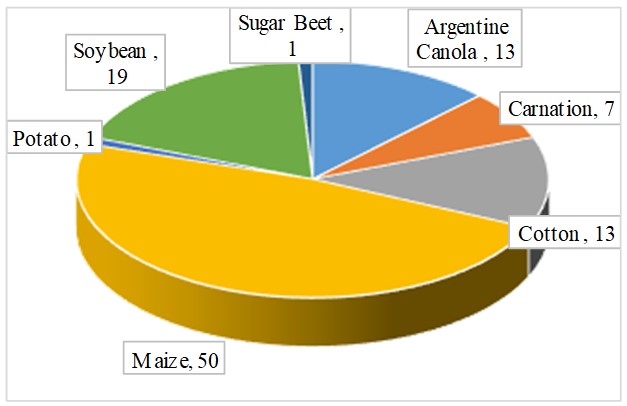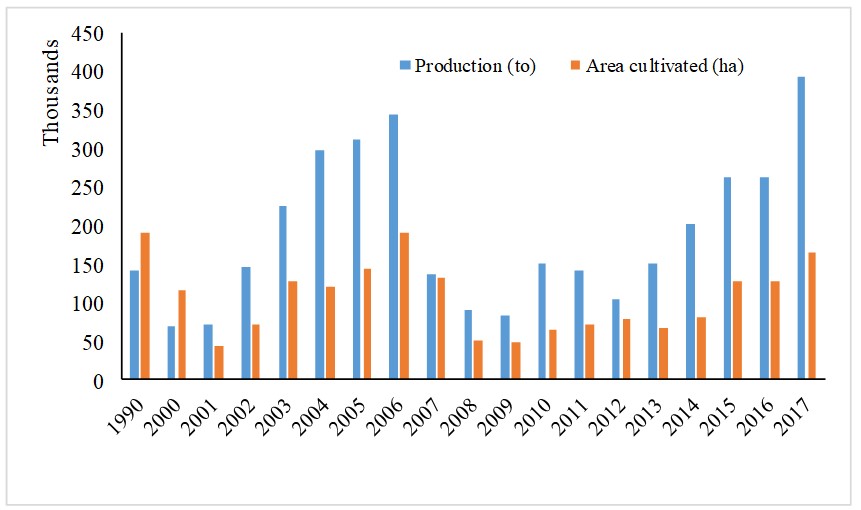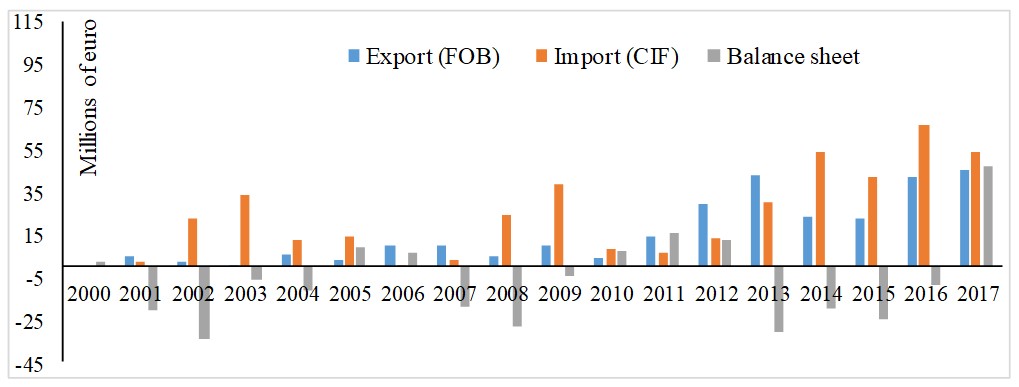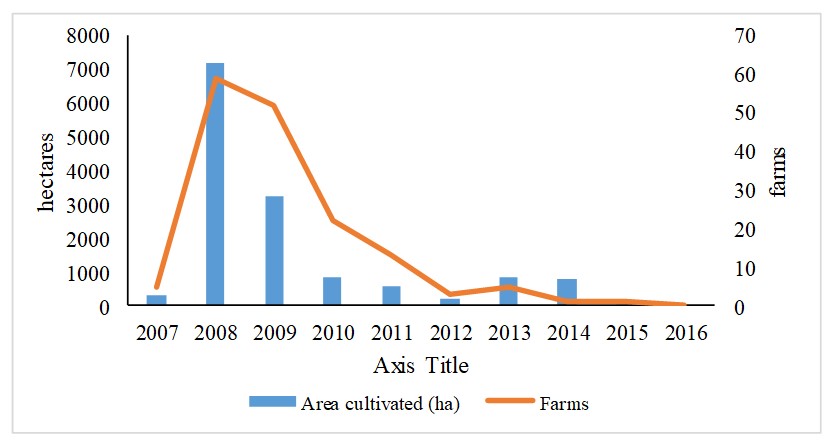Introduction
The European legislation has defined GMO’s as the organisms “in which the genetic material has been altered in a way that does not occur naturally by mating and/or natural recombination” (EC, 2001).
According to Millestone et al. (2011), the community legislative has focused on the biotechnological process to create a new organism and less on the genetic characteristics for the transgenic product resulted. The current regulations could become inefficient, being surpassed by the progress recorded in the genetic modification techniques (GM). The products launched on the initial period of GM were different from the structure of DNA, they are comparative to the organisms from which they came. The initial procedures on risk evaluation of GMO’s were focused on DNA translocation and the migration of new characteristics to natural plants or animals. The modern techniques used to create transgenic entities make it very difficult to identify the difference between GMO’s and conventional organisms. Therefore, the use of some modern techniques of genetic recombination may create difficulties in the identification of the transgenic organisms; the methods based on the authentication of DNA are inefficient.
The enforcement of some systems based on the administrative audit trails in order to reflect the traceability of the products, close to those used in the ecological production, can be useful in the checking of the origin and OMG identity(EC 1829/2003).The significant progress recorded in obtaining GMO led to an increasing spread of the transgenic cultures. The researchers hope to obtain from these solutions, in order to solve the problems of food security, the reduction of pollution of the environment and the lucrativeness of the agricultural exploitations.
Materials and Methods
The researches carried out within the work used information given by the national statistics database (NIS, ISTIS), European (Eurostat) or international (FAO Stat, ISAA).The data were collected, statistically worked and interpreted. The results obtained were analysed and compared with the information provided by the acknowledged scientific institutions (the Romanian Academy, the Academy of Agricultural and Forestry Sciences), the European Commission, treaties and articles of speciality. The relevant and credible media information was selected for the completion of the research.
Commercial cultivation of GM crops on the world
According to the data provided by the ISAA Reports (2015), the year 2014 remarked itself by a spectacular increase of the surfaces cultivated with transgenic plants; from 1.7 million hectares in 1996 to 181.5 million hectares in 2014. The OMG sector is one of the most dynamic economic sectors, with an annual rate of increase of 3-4%.The important benefits brought to the farmers led to the extension of the agricultural systems based on the GM, applied today in 28 countries, in comparison to 6 countries in 1996.The developing countries are those that adopt rapidly the new system of agricultural production, the majority of the states that use the transgenic crops are in the process of developing.
Bangladesh is the last state that approved the cultivation of the transgenic plants, and from 2015, Vietnam and Indonesia approved the commercialization of the GM crops obtained in 2014.
The global distribution of the surfaces cultivated with GM plants is unbalanced (Figure 1) .The USA with a share of 40,3%, together with Brazil (23,3%) and Argentine (13,4%) cover more than 75% from the total of the GMO cultivated surfaces on a global scale. Romania, with total surfaces allocated to these cultures under 50,000 ha is situated at the other end of the top list.

Figure 1: Global Area of Biotech Crops in 2014: by Country (ISAA, 2014)
The most frequent cultivated GMO’s in the world are cotton for textile fibers, followed by soybean and maize for feed, technical plants and crops for food (Guertler and Busch, 2013). The main benefits associated with 20 years of transgenic production, according to Brookes and Barfoot, cited by ISAA (2014), are favourable impacts on food security, sustainability and climate change by increasing the plant production, reducing the pesticide consumption and reducing the CO2 emissions. Applied in 18 million small farms, transgenic crops production has improved the lives of over 65 million people worldwide (ISAA, 2014).
Commercial cultivation of GM crops in Romania in Europe
Given that genetically modified organisms are treated with suspicion by European consumers, the European Union has cautiously treated the cultivation and use of transgenic plants. Community guidelines have meant to implement measures to prevent environmental degradation and to avoid adverse effects on human health and the environment (Merca, 2012).
Community legislation has been adapted to the progress of genetic technologies, with successive regulations on experimentation, deliberate release and placing on the market of genetically modified organisms, traceability and labeling of genetically modified organisms, traceability of food and feed products from organisms genetically modified (EC, 2011). Directive 2001/18 / EC on the Environmentally Released of GMOs and EC Regulation 1829/2003 on genetically modified food and feed establish the prior authorization for the placing on the market of GMOs. Both documents are based on scientific data on human health, animal health and environmental risk assessment.
Regulation 1830/2003 stipulates standards for the traceability and labelling of genetically modified organisms and the traceability of GMO products of animal origin and feed. Food products containing more than 0, 9% GMO must be labelled with this specification. For GM crops that have not been approved on the EU market, a zero tolerance policy applies. GM crops accepted on the EU market must undergo a rigorous approval process (Guertler and Busch, 2013). The European Food Safety Authority (EFSA) and the scientific authorities of the Member States MS are responsible for the scientific evaluation. According to the GMO Registry, in 2015, 48 GM crops (cotton 7, maize 28, 2 modified microorganisms, 3 oilseeds rape, 7 soybeans, 1 sugar beet) were authorized as food in Europe (EC 2015).
MS adopts supplementary measures of restriction or of forbidding on the cultivation of all the OMGs or on some of them, on all their territory or only in parts of this, according to some reasons, other than those already approved in the set of harmonized rules of the EU (EC, 2010). The period 1998-2015 brought the approval of the cultivation of only 5 transgenic plants on the territory of the UE, among which, in crop, for commercial aims, the BT corn from Monsanto is only present; MON810; an approval request was submitted for a variety of PIONIEER corn. According to the EC (2013), MON 810 was cultivated in Spain in 2012 (116 306 hectares), Portugal (9 278 hectares), Czech Republic (3, 052 hectares), Romania (217 hectares) and Slovakia (189 hectares). Total agricultural land planted with transgenic corn represents 1,35 % from the 9,5 million hectares of corn cultivated in the EU and 0,23 % from the 55,1 million hectares of corn genetically modified, cultivated everywhere in the world. Eight member states (Austria, Bulgaria, Greece, Germany, Hungary, Italy, Luxembourg and Poland) adopted measures of safeguarding and they forbade the MON810 genetically modified corn cultivation, on their territories. The European Commission took Europe another step closer to plant GMO crops in 2015, announcing that it had fast-tracked the approval of 17 GM crops (10 new authorisations and 7 renewals) – and 2 GM flowers. Currently, according to the ISAA website (2018), the EU is approved for food – direct use or additive, 97 crops, including canola, maize, sugar beet or soybean and 7 varieties of Carnation (figure 1).

Figure 1: GMO’s approved in EU for food – direct use or additive
Source Author, by using ISAA (2018)
Commercial cultivation of GM crops in Romania
In pre-accession to the EU, local farmers have shown interest in genetically modified crops. The Lack of regulatory regulation and confusion over the effects of transgenic crops have allowed the massive development of genetically modified soybeans or corn crops for commercial use. At present, national legislation on GMOs is in line with European directives. With 27 GMO regulations, Romania is the Member State with the most regulations, but the legal approach to transgenic issues is complicated and allows for interpretations. According to INFOMG (2015), most GMO regulatory documents have not been debated publicly and have deficiencies in practical application. Therefore, the prohibition of plant transgenic soy in 2007 was formal and eradication actions of cultivated areas were prone to superficiality. Although banned in 2007, there were suspicions of illegal cultivation of GMOs in some areas of Romania some years after accession (Greenpeace, 2014).
InfOMG (2015) shows that allowing GM soy varieties in Romania was ineffective. In official documents for legalization of transgenic crops, there is no complete information on the location and size of crops, cultivated varieties, seed origin or destination of production. Data on total areas cultivated with genetically modified soy have been erroneously processed and there are many inaccuracies regarding cultivated areas. Although there were media reports on the cultivation of genetically modified soy in Romania since 1998, no official records on areas planted between 1998 and 2004 (Greenpeace, 2014).
According to ISTIS (2004), in the period 1998-2007 14 GMO soy varieties tolerant to the herbicide glyphosate treatment were approved in Romania. Complete information on these crops are only available for 2004-2006. The right to commercialize genetically modified soybeans for commercial cultivation on the Romanian market was owned by 5 companies (Monsanto, Pioneer, Delkab Genetics Corporation, Asgrow Seed and Seeds Stine). RR OMG soybean, supplied by Monsanto, was the most cultivated variety by Romanian farmers. The evolution of the areas cultivated with GMO soybean is presented in table 2.
There are no data for the pre-2004 period. In 3 years, the cultivated areas have evolved rapidly, increasing over 25 times; from about 5,500 ha in 2004 to about 140,000 ha in 2006. EU integration banned the genetically modified soybeans in Romania.
Table 2: Area cultivated and GMO soybean varieties in Romania (ISTIS, 2004)

The universities opinion on GM soybean cultivation in Romania is different comparing to InfOMG or Greenpeace Romania. Hence, the GMO soybean cultivation argues the favorable natural conditions for these crops and the agricultural area of between 500,000 and 1,000,000 hectares, the domestic demand for vegetable protein (400,000 to/year) or the potential for export of 2,000,000 tons/year, production of soybean fuel, and reduction of pollution or additional benefits for local farmers (Romanian Academy and ASAS, 2009). Studies on the environmental impact of cultivation of GMO soybean RR have shown the lack of negative effects associated with these crops on weeds, insects or microorganisms in the soil.

Figure 4: Production and area cultivated with soybean
(Source NIS 92018)
The ban on the cultivation of the GMO soybean influenced domestic production and area cultiveated, which recorded a significant decline after 2007 (figure 4). It can be noticed that the joining at EU and the new restrictions imposed on Romania diminished the domestic production of soybean and increased the dependence of the Romanian sector on imports. A complete analysis must include the price of the soybean on the international market, the stock market or the influence of the economic crisis.

Figure 5: Romanian Soybean trade (millions of euro)
Author, using NIS (2015)
Joining the EU, the cultivation of transgenic maize MON810 (Monsanto) has been allowed in Romania, authorized at a community level and resisting the Ostrinia Nubilialis. The right of commercialization of the seeds MON810 was held in Romania by Monsanto, Pioneer and Limagrain. In 2009, local farmers cultivated approximately 2 million hectares with MON810. According to INFOMG (2015), Romania as traditional producer for maize, does not have studies focused on the impact of the GMO on the traditional varieties. It applied the community experience; Europe is considered an area with a reduced risk of GMO maize, because there are no wild varieties of this plant; susceptible to translocations. The evolution of farms number and the area cultivated with MON810 are presented in figure 6. The data showed a reduction of GMO maize producers from 58 farmers (2008) to 5 (2014) and a reduction of the area cultivated from 6,130 ha in 2008 to 770 ha in 2014. After the spectacular growth of the transgenic maize fields and farms in Romania during 2007-2008, there was a strong decline in the recorded values, and there is now no transgenic corn cultivated areas (figure 6)

Figure 6: MON810 Maize in Romania
Source Author, by using MARD (2018)
Romanian population has suspicions concerning the OMG food, for the possible interactions with the human genome. The National Food Survey of the GMO was conducted online in September 2011 and included the responses of 2707 respondents. The results of the survey are presented in figure 7.

Figure 7: Consumer Survey: Do you agree with genetically modified foods?
(Online Survey, 2011)
The majority of the respondents is reticent about GMOs in food or feed (Bodeanu, 2011). For the microbiologist, the effects of MON cultivation were positive; the harvests have significant reduction of the molds contamination with low level of mycotoxins. In 2007-2012, there were no harmful effects identified on the of the soil microbiota or for the insects, due to the cultivation of MON810. According to the Romanian Academy and ASAS Report (2009) for GMO’s, the academics are favorable to the use of transgenic maize, arguing with the advantages as better productivity (increased of 10-15%); additional profits for farmers (20-259 euro/ha); and the good profitability for the transgenic cultures (increased of 9-418 %).
Conclusions
Global farmland surfaces, which are cultivated with GMO, have known a spectacular development in the last few years. The consumers ‘attitude towards genetically modified foods is dependent on the economic conditions and on the media information, which are most often than not, inconsistent from a scientific point of view. The present paper proposes an economic analysis of the GMO’s use in the national food production in the community and international context. When Romania joined the EU, the local farmland became less and less cultivated with genetically modified plants; a fact that led to important economic loss for national economy. Although there are some restrictions regarding GM crops, the Romanian market is an important genetically modified fodder importer. From an economic point of view, the use of genetically modified organisms, if the biosafety criteria are obeyed, represents a solution for global food necessary coverage.
Acknowledgements
This paper was co-financed from the European Social Fund through Sectorial Operational Programme Human Resources Development 2007-2013, project POSDRU number /159/1.5/S/138907 “Excellence in scientific interdisciplinary research, doctoral and postdoctoral school, in the economic, social and medical fields-EXCELIS”, coordinator The Bucharest University of Economic Studies.
References
- Bodeanu, T, (2011), Do you agree with the genetically modified food? Online Survey (09.2011), com, [Online], [Retrieved April, 12, 2015], http://www.ziare.com/mediu/omg/sunteti-de-acord-cu-alimentele-modificate-genetic-sondaj-ziare-com-1120529 ;
- European Commission (2001) Directive 2001/18/EC of the European Parliament and of the Council on the deliberate release into the environment of genetically modified organisms and repealing Council Directive 90/220/EEC, Official Journal of the European Communities (17.4.2001): L106/1, [Online], [Retrieved March 22, 2015], http://www.biosafety.be/GB/Dir.Eur.GB/Del.Rel./2001_18/2001_18_TC . html;
- European Commission, (2003), Regulation (EC) 1829/2003 on genetically modified food and feed, Official Journal of the European Communities [Online], [Retrieved March 02, 2015], http://ec.europa.eu /food/food/animal nutrition/labelling/Reg_1829_2003_en.pdf;
- European Commission, (2010), Communication of the commission towards the European parliament, council, economic European social committee and the committee of the regions concerning the freedom of decision of the member states with respect to the genetically modified crops, COM (2010) 375 final, Official Journal of the European Communities, [Online], [Retrieved March 10, 2015], http://www.madr.ro / organisme-modificate-genetic.html , accessed March, 2015;
- European Commission, (2011), Evaluation of GMO policy in the EU, Official Journal of the European Communities [Online], [Retrieved March 15, 2015], http://ec.europa.eu/food/food/biotechnology/index _ en.htm;
- European Commission, (2013), Notice of acknowledgement Questions and answers concerning the politics of UE concerning the cultivation and the imports of OMG”s, Official Journal of the European Communities [Online], [Retrieved April, 04, 2015], available on http://europa.eu/rapid/press-release_ MEMO-13-952_ro.htm;
- European Commission, (2015), GMO” Species data, EU Register of authorized GMOs, [Online], [Retrieved March 22, 2015], http://ec.europa.eu/food/dyna/ gm register/ index_ en. cfm;
- Greenpeace Romania, (2014), In Romania there are still illegal cultures of genetically modified soya. Press Report (30.09.2014), [Online], [Retrieved March 29, 2015], http://www.greenpeace.org/romania/ ro/ campanii /agricultura-sustenabila/activitati/soia-modificata-genetic-in-romania;
- Guertler, P., Busch, U, (2013), Surveillance of Genetically Modified Plants in Food, Feed and Seed, The World of Food Science, [Online], [Retrieved March 29, 2015], http://worldfoodscience. com /article/surveillance-genetically-modified-plants-food-feed-and-seed;
- Info Center about Genetically Modified Organisms – INFOMG, (2015), GMOs in Romania. Data concerning the cultivation of the genetically modified organisms in Romania, [Online], [Retrieved February 22, 2015], http://www.infomg.ro/web/ro/Situatia_in_Romania;
- International Service for the Acquisition of Agri Biotech Applications ISAAA, (2015), ISAAA Brief 49-2014: Top Ten Facts, Biotech Information Resources [Online], [Retrieved April, 01, 2015], http://www.isaaa.org/resources/publications/briefs/49/toptenfacts/default.asp;
- International Service for the Acquisition of Agri Biotech Applications – ISAAA, (2014), ISAAA Brief 49-2014: Executive Summary Global Status of Commercialized Biotech/GM Crops: 2014, Biotech Information Resources [Online], [Retrieved April, 01, 2015], http://www.isaaa.org/resources/ publications /briefs/49/executive summary/default.asp,;
- Merca, M.I.C., (2012), The genetic Pollution. Legal economic and social implications, Summary PhD thesis, Bucharest University, Law Faculty;
- Millstone, E., Stirling, A., de Vriend, H., Spoek, A., Schenkelaars, P., (2011), Evaluation of the EU legislative framework in the field of cultivation of GMOs under Directive 2001/18/EC and Regulation (EC) No 1829/2003, and the placing on the market of GMOs as or in products under Directive 2001/18/EC, Final Report, DG SANCO, European Commission, [Online], [Retrieved April, 12, 2015], http://ec.europa.eu/food/food/biotechnology/evaluation/docs/gmo_cultivation_report_en.pdf ;
- Ministry of Agriculture and Rural Development, (2015), GMO”s, Reports, [Online], [Retrieved April, 15, 2015], http://www.madr.ro/organisme-modificate-genetic.html;
- The National Institute of Statistics NIS, (2015), Trade Statistics, Tempo online, [Online], [Retrieved April, 04, 2015], http://statistici.insse.ro/shop;
- The Romanian Academy and ASAS – The Academy of Agricultural and Forestry sciences, (2009), Position of the academic environment concerning the genetically modified plants, Romanian Government, [Online], [Retrieved April, 09, 2015], http://www.madr.ro/organisme-modificate-genetic.html;
- The Romanian Agency for Environmental Protection ANPM, (2015), Records concerning the GMO”s 2007-2014 cultivation/locations, Section Biosecuritate – Subsection Registre, [Online], [Retrieved April, 04, 2015], http://www.anpm.ro/ register;
- The State Institute for Variety Testing and Registration ISTIS, (2004), The official Catalogue of the types of plants of crop from Romania for the year 2004-2006, The genetically modified types, Ministry of Agriculture, Online], [Retrieved April, 10, 2015], http://www.istis.ro/blogs/ro/archive/2004/01/30/ Service-hortic.aspx ;










